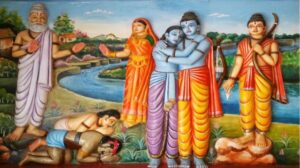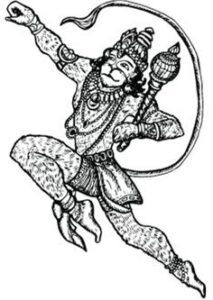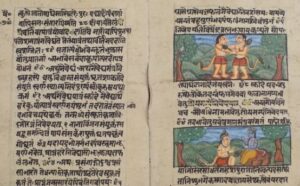Ancient Text Modern Relevence
Timeless Wisdom From the Ramayana

Many are introduced to yoga through yoga asana, breathing techniques, and meditation techniques. All of these practices bring myriad physical, mental, and emotional benefits. It is, however, with the addition of India’s traditional philosophical texts that one can understand the full extent of yoga’s capacity to enhance wellness.
One such narrative is the Ramayana. Thought to have been composed around the 8th century BCE by Maharishi Valmiki, it is the life story of Lord Rama, the seventh reincarnation (avatar) of Lord Vishnu. This important historical epic has heavily influenced the religion, philosophy, and ethics of Indian culture. Its teachings continue to have relevance for even the modern-day spiritual aspirant.
 This epic tells the story of Lord Rama’s exile from his country, the fantastic adventure and challenges that ensue, and finally his return home. For yoga students in the West the best-known portion of this story is probably when Hanuman (the monkey god) leaps from India to Sri Lanka to retrieve Rama’s kidnapped wife, Sita.
This epic tells the story of Lord Rama’s exile from his country, the fantastic adventure and challenges that ensue, and finally his return home. For yoga students in the West the best-known portion of this story is probably when Hanuman (the monkey god) leaps from India to Sri Lanka to retrieve Rama’s kidnapped wife, Sita.
This famous leap symbolizing selfless love and devotion to Lord Rama is the inspiration for the full split yoga pose entitled Hanumanasana.
The Characters of the Ramayana display extraordinary examples of devotion, courage, patience and ethics in the face of great suffering. The teachings of this story are many, and they continue to be transferable to trials and tribulations of today’s context. It is a timeless teaching that gives direction and hope as one maneuvers the complexities of existence.
While the symbolism of this epic encompasses much wisdom, one of the most commonly studied topics is the nature of selfless love. The Ramayana is sometimes described as an example of the triumph of good over evil, or of love over adversity. Selfless love is presented as a source of immense power and strength in the darkest hours of one’s life, and ego as a source of suffering.
The ego of the demon Ravana led him to care only about what he could gain from the people and the resources around him. In contrast, Hanuman’s actions exemplified selfless love and devotion which conquered ego and allowed for a return to love.
 These teachings are not meant to be studied in isolation, or even from a book for that matter.
These teachings are not meant to be studied in isolation, or even from a book for that matter.
They are born of living oral traditions, that are meant to provide fluid insights relevant to different situations, people, and times. This epic is ancient wisdom best studied with a teacher, and/or with a group of seekers. The Ramayana holds great universal truths meant to be a stimulus for contemplation as one’s life situation and spiritual maturity shifts. The Ramayana brings different insights to me today than it did when I originally studied it a couple of decades ago.
Today I return to Hanuman’s example of selfless love in daily interactions when I find myself withholding love and acceptance until someone acts as I want them to. This includes interacting with a life situation that is not as I desired it to be. The Ramayana reminds me that withholding love and acceptance because someone or something is not as I anticipated it should be is a recipe for pain and anger. It is an act of self love to detach from depending on the state of other people or the world when deciding when to act in love. The insightful Ekhart Tolle teaches us to approach every situation as if we had chosen it. This does not mean that we have have sit back and take everything as it comes. As Hanuman’s example of active interaction with the world demonstrates, one can be devoted to selfless love and acceptance without necessarily remaining passive, indeed even selfless love is a conscious active decision.
I invite you all to ponder the ways in which you may be withholding love and acceptance in your interactions, attitudes and relationships as you continue to navigate the complexities of the human experience.
If you are interested in more deeply contemplating the Ramayana with a dedicated group of yoga students, and in the location that Lord Rama and his wife Sita were exiled you might want to consider joining Bobby’s Shakti Yoga retreat in Nashik India March 2024. This will be a true ashram retreat, with a deep dive into the Ramayana, and for those interested in such things, an opportunity to accumulate 80 Yoga Alliance CEUs or 100 hours of study toward a Shakti 300 hour Yoga Teacher Training certification.
Articles
-
Two Reasons to Make Neurogenic Yoga a Regular Part of Your Life
-
Five Reasons to Study Yoga Nidra
-
Ancient Text Modern Relevence
-
Tips From a Chick on Using Stress to Get Healthier!
-
Calming Chocolate Date Bark
-
The Psoas, Sitting, and Stress Connection
-
Massaged Kale and Goat Cheese Salad
-
Becoming a Yoga Teacher
-
Tips to Enhance Your Year of the Rabbit
-
5 Immune Boosting Poses for Deep Core Wellness

